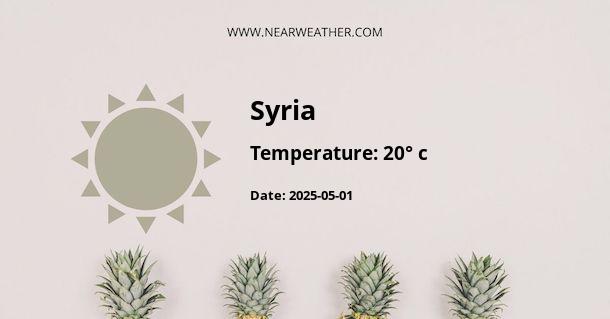Introduction
The Syrian Arab Republic, commonly known as Syria, is situated in Western Asia. Bordered by Lebanon to the west, Turkey to the north, Iraq to the east, Jordan to the south, and Israel to the southwest, Syria enjoys a diverse climate that ranges from Mediterranean on the western coast, to desert climate in the east. The diverse topography and geographical location play a significant role in the weather variations across the country.
Overall Climate
Syria's climate is characterized by two main seasons: a hot, dry summer and a mild, rainy winter. Summers, from June to August, are typically hot with temperatures in the lowlands ranging from 25°C (77°F) to 35°C (95°F). Winters, from December to February, are mild and rainy, with temperatures averaging around 10°C (50°F). The coastal region enjoys a Mediterranean climate with hot, dry summers and mild, wet winters. The inland areas, however, have a semi-arid climate, with hot, dry summers and cool, relatively rainy winters.
Regional Variations
The coastal regions have a Mediterranean climate, characterized by hot, muggy summers and mild, wet winters. The average high temperature in August is around 30°C (86°F), while in winter, temperatures usually hover around 15°C (59°F).
The inland regions experience a semi-arid climate, where summers can be scorching hot with temperatures often exceeding 40°C (104°F). Winters are cooler and relatively wet with temperatures averaging around 10°C (50°F).The eastern part of Syria experiences a desert climate, characterized by extremely hot, dry summers and cool, dry winters. Here, summer temperatures can exceed 45°C (113°F) and winter temperatures can drop to around 5°C (41°F).
Seasons
Spring (March - May): Spring in Syria is mild and considered the best time to visit. Temperatures gradually increase, and rainfall decreases, making it an ideal time for outdoor activities.
Summer (June - August): Summers in Syria are hot, especially in the desert regions. The coastal regions are cooler due to the Mediterranean sea breeze.
Autumn (September - November): Autumn is similar to spring in terms of weather. Temperatures start to drop, and there is little rainfall. This is another good time to visit Syria.
Winter (December - February): Winters are mild and rainy. Snowfall is rare, except in the mountains. The desert regions can get quite cold at night.
Annual Weather Averages in Syria
| Month | Average High Temperature (°C) | Average Low Temperature (°C) | Average Rainfall (mm) |
|---|---|---|---|
| January | 10 | 4 | 190 |
| February | 12 | 5 | 170 |
| March | 16 | 7 | 110 |
| April | 21 | 11 | 40 |
| May | 26 | 15 | 10 |
| June | 30 | 19 | 0 |
| July | 34 | 22 | 0 |
| August | 34 | 22 | 0 |
| September | 30 | 19 | 0 |
| October | 25 | 14 | 20 |
| November | 19 | 9 | 70 |
| December | 12 | 6 | 130 |
Best Time to Visit
The best time to visit Syria is during spring (March to May) and autumn (September to November) when the weather is pleasant, and the landscapes are lush. These periods offer comfortable temperatures, ideal for exploring the country's historical sites and natural beauty.
Conclusion
Weather in Syria is diverse due to its varied topography and geographical location. Understanding these variations can help plan a trip accordingly. Whether you want to explore the Mediterranean coast, the semi-arid inland, or the desert east, knowing what to expect from the weather can significantly enhance your experience.
A - Syria's Latitude is 35.000000 & Longitude is 38.000000.
A - Weather in Syria is 9° today.
A - Climate Conditions in Syria shows broken clouds today.
A - Humidity in Syria is 64% today.
A - Wind speed in Syria is 20.41 km/h, flowing at 183° wind direction. today.
